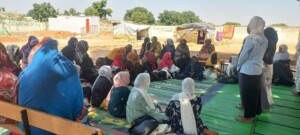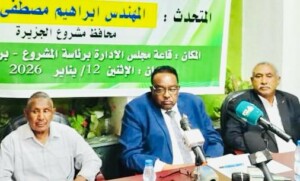Sudan OCHA bulletin 15: Floods affect 9,000 people in South Darfur’s Kalma camp
On 20 June, torrential rains and flash flooding affected an estimated 9,000 people (1,780 families) in Kalma camp for the displaced in South Darfur. In Jebel Marra. Unicef, the Central Darfur Ministry of Health, and partners have carried out campaigns to combat the spike in malnutrition. The influx of South Sudanese refugees into Sudan continues and is now at an average rate of 230 refugees daily, which is lower than the peak of 1,500 reported in May.
On 20 June, torrential rains and flash flooding affected an estimated 9,000 people (1,780 families) in Kalma camp for the displaced in South Darfur. In Jebel Marra. Unicef, the Central Darfur Ministry of Health, and partners have carried out campaigns to combat the spike in malnutrition. The influx of South Sudanese refugees into Sudan continues and is now at an average rate of 230 refugees daily, which is lower than the peak of 1,500 reported in May.
The UN Office for the Coordination of Humanitarian Affairs (OCHA) in Sudan reported in its latest bulletin that an inter-agency team visited Kalma camp on 22 June to determine the needs of then people affected by the rains.
Basic schools in the camp were in need of rehabilitation before the start of the school year in July.
Some of the affected families have already relocated to areas of higher ground while others will move to Beleil town a few kilometres south-east of the camp.
The governmental Zakat Chamber donated 1,000 plastic sheets, 200 sacks of sorghum, and 150,000 SDG in cash assistance (about $23,000), which were distributed to the displaced in need. The International Organization for Migration (IOM) is carrying out house-to-house verification for the affected families. Oxfam, CARE International Switzerland (CIS) and American Refugee Committee (ARC) are distributing building materials for latrines.
OCHA is currently advocating with Unamid for heavy machinery to dig trenches and channels to allow water to flow easily away and with the UN Development Programme (UNDP) and the Civil Defence Authority for long-term mitigation measures to be put in place, as this situation has been recurring annually for the past 10 years.
‘Find and Treat’ campaign responds to malnutrition in Jebel Marra
Unicef, the Nutrition Department of the Central Darfur Ministry of Health, and partners carried out campaigns to combat the spike in malnutrition in West and Central Jebel Marra localities.
The campaign is part of a multi-sector response plan developed by aid organisations in June to address the high prevalence of severe acute malnutrition (SAM) in the Jebel Marra area, as reported by the federal Ministry of Health.
Unicef launched a SAM treatment campaign called ‘Find and Treat’—in partnership with the Health Ministry and aid organisations—to deliver a package of integrated lifesaving services.
The first of four rounds of the campaign covered 69 villages in West Jebel Marra locality and 83 villages in Central Jebel Marra locality, where 42,667 children under five years of age were screened. Of these, nearly 800 were suffering from SAM, while 3,909 children had moderate acute malnutrition. All children with SAM were admitted to Outpatient Therapeutic Feeding Programmes.
To treat children with medical complications from SAM, the Golo Stabilisation Centre was established and within one week 16 children with life-threatening forms of SAM were admitted. More than 700 infants were immunised against measles.
There are an estimated 23,000 school-aged children in need of educational support in the area.
Children continue to bear the brunt of multiple emergencies in Sudan
On 28 June, Unicef announced that it needs $22 million to provide lifesaving assistance to over 100,000 children in the country.
Over the last few months, Sudan has faced multiple new humanitarian needs, with the rapid spread of suspected cases of acute watery diarrhoea (AWD), a significant influx of South Sudanese refugees into the country, and high rates of malnutrition especially in the Jebel Marra area of Central Darfur.
The federal Ministry of Health and WHO have reported that more than 16,600 AWD cases were identified in the country over the past 10 months. An estimated 20 percent of the affected cases are children. White Nile State is the most affected area with at least 5,800 reported cases. There is concern that the situation can worsen with the imminent onset of the rainy season.
According to UNHCR registration figures, of the 155,000 South Sudanese refugees who have arrived in Sudan in 2017, about 100,000 (65 percent) are children.
South Sudanese refugee influx continues
The influx of South Sudanese refugees into Sudan continues and is now at an average rate of 230 refugees daily, which is lower than the peak of 1,500 reported in May. This is mainly owing to the start of the rainy season.
The total number of refugees who arrived in the country since mid-December 2013 is now 403,000, of whom more than 155,000 arrived this year, according to UNHCR.

As of 2 July, Sudan’s requirements for the South Sudan Regional Refugee Response Plan – revised in May 2017 to reflect the new large-scale influx – is 16 percent funded.
In South Darfur, 2,200 South Sudanese refugees have arrived at the border of El Radoom locality and South Sudan. The government’s Commissioner of Refugees (COR) and UNHCR are currently relocating these refugees to El Radoom town for their safety and access to basic services.
In South Kordofan, UNHCR, COR, HAC and the Sudanese Red Crescent Society (SRCS) led a joint assessment to remote locations in Abu Jubaiha locality where about 2,000 South Sudanese refugees arrived. UNHCR will distribute emergency household supplies to the new refugees.
White Nile state
The Health Ministry of White Nile state has reported an estimated 5,800 AWD cases across White Nile since August 2016, of which 31 cases are South Sudanese refugees.
Health screenings are ongoing for all new arrivals at the El Megenis entry point, and SRCS is managing an AWD isolation tent at the entry point for identified cases. The Health Ministry and health partners are rolling out a state-wide response plan to contain the situation and emergency health task forces have been established at state and locality levels.
Locality authorities in White Nile’s El Salam locality have approved the extension of five refugee camp sites, including El Waral, Um Sangour, Jouri, El Redis II and El Kashafa. The additional land will help to decongest El Waral and Um Sangour camps by providing space for an additional 10,000 households (about 55,000 people) and will allow for improvement in water and sanitation services.
According to UNHCR, education response for South Sudanese refugee children across all affected states in the country remains a critical gap, with nearly 60 percent of school-aged refugee children out of school.











 and then
and then